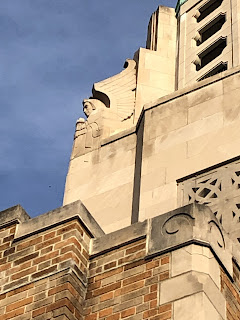When I first became a dedicated cyclist--nearly half a century ago!--bicycles were touted as environmentally friendly alternatives to gas guzzlers. At the risk of sounding like someone who pines for "the good old days," I'll say that most adult cyclists of the time were not merely "signaling" their concern for our habitat; they, as often as not, made other choices in line with their values.
Today, while some are "bikewashing" their lifestyles, there are some who are genuinely concerned with such matters as human-enhanced climate change. So, while they might cycle to work or school (or, at least to the bus or train that takes them there), recycle the bottles, cans and other packaging they use during their lunch breaks and, perhaps, try to buy as local as possible, they could unwittingly be making at least one choice that undermines their other efforts.
To wit: Their bicycles might be part of the problem. Now, I don't mean to be pick on such folks. Most people, especially if they're buying their first bike in decades, aren't familiar with how or where their bikes are made, or anticipate the normal wear and tear--and repairs--that come with regular use. They also assume that "new is better," which is sometimes, but not always true.
Most mechanics, or anyone who's been cycling for, say, two decades or more, won't necessarily agree that "new is better." It's true that almost any derailleur made today shifts better than almost any made fifty or forty years ago. And, depending on your point of view, some other parts today are more efficient, convenient or lighter than their predecessors.
But one problem is that most of those parts--or the bikes themselves--are not built to last because they're not made to be fixed. "If I get a Huffy from the '90's, chances are I can actually make repairs to it," says Mac Liman. It will be heavy, but at least "the steel will hold together," she explains, and the result will be a serviceable, if inelegant, piece of basic transportation.
Liman would know: She's been a mechanic for 19 years, the past 14 at Denver's Bikes Together shop. Those Huffys were sold mainly in big-box shops like Wal-Mart, which sold out all of its bikes in March 2020. "We're already starting to get those bikes," Liman lamented, "And we can't fix them."
One problem is the shortage of available parts caused by COVID-19-related manufacturing and supply chain disruptions. But an even bigger issue is simply the poor quality of those bikes: Their frames crack and they have non-standard parts that can't be replaced at a reasonable price. "I've seen bearing cups that just fall out of hubs, so there's no way you can rebuild them," Liman says.
Her experiences have led her to join a petition calling for bikes to be repairable. Its earliest supporters were mechanics at non-profit bicycle co-operatives and training programs like Recycle-A-Bicycle. Cheap bikes from big-box stores are often donated, or brought in for repair, to such shops. And people who buy bikes from such places are looking for something good and reliable for not very much money.
Now I have to admit that I was once one of those elitist bicycle snobs who snickered when I saw a department-store bike. But I now understand that people buy such bikes, not because they're stupid, but because they don't know (yet!) why they should--or can't afford--to buy something better.
So, making unrepairabe bikes, like making almost anything else that's disposable, contributes to degrading the very environment some for which some folks are signaling their support by being seen on a bike. And, as with so many other environmental issues, it's also a matter or social and economic justice, because it affects the working poor even more than those who buy those shiny-new Linuses and Brooklyn bikes.








